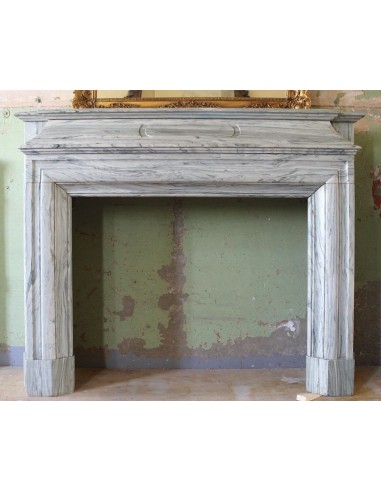BOUDIN FIREPLACE CARVED IN "AQUAMARINE" MARBLE (MORE PRECISELY, "APUAN MARINE CIPOLLINO"), MID-NINETEENTH-CENTURY SCULPTURE, EXCELLENT OVERALL PRESERVATION, FROM THE CÔTE D'AZUR.
The marble “Cipollino marino” possesses a white background containing bright green veins, very subtle and arranged in cusped waves, reminiscent precisely of the ripples of sea waves. This description of the marble with which the fireplace I am presenting to you was built is given to us by ISPRA (Istituto Superiore per la Protezione e la Ricerca Ambientale), in an almost poetic manner.
But this delicacy and beauty of it is not the only characteristic of our fantastic (if only because it makes us dream of Caribbean beaches) marble. You should know, in fact, that this marble fabric could arouse the envy of Scrooge McDuck de noaltri (Il Berlusconi Silvio) since the quarrying of our Cipollino ended perhaps a century ago (no one knows exactly when) and therefore we must count this precious material among the ancient marbles. By the way, even when it was “alive,” very few blocks were extracted because its quarry was so small as to be almost unknown to most people.
NO ONE IN THE WORLD WILL EVER AGAIN BE ABLE TO OWN A WORK OF SCULPTURE IN THIS PRECIOUS MATERIAL.
We all know how its builder, the for me mythical Boudin, was reluctant to use marbles that were not indigenous (and therefore French), but I hypothesize that HE, who lived and worked between Nice and Marseilles (so surely of the sea he was a lover) was fascinated by this marble because its surface represents the most beautiful sea there can be, the one whose waves lapping in our Fantasy.
SIDE NOTES: ECOLOGY AND ANTIQUE FIREPLACES
There has long been a lot of talk about ecology issues, the need to maintain some environmental harmony before running into total disaster, well, choosing an antique fireplace instead of one of modern industrial production can also make its small contribution to this cause.
Why, you may ask?
But because an antique fireplace is made of a marble or stone that has already been quarried, and therefore does not need newly quarried materials.. Our Apuan Alps, already so disrupted by millennia of quarrying, certainly do not need any more scarring, and so for all those extractive situations everywhere, wildly (especially in the so-called “emerging” countries..) disfigured in their appearance and morphology with the inevitable hydrogeological consequences.
Another “ecological” point in favor of the ancient fireplace lies in the fact that ancient fireplaces were assembled with entirely natural materials (especially with plaster together with natural stones or bricks) and not with plastic or silicone mastics as is the case today. Their carving, then, was entirely manual, and did not produce those waste slurries that modern machines (“PANTOGRAPHERS”) spit out with every piece and which we then, perhaps, find ourselves illegally dumped in the sea or in some disused quarry given the high cost of their disposal by law... In short, it can certainly be said that the antique fireplace was “environmentally friendly” even at the time of its construction!
Think about it people, think about it...








































































